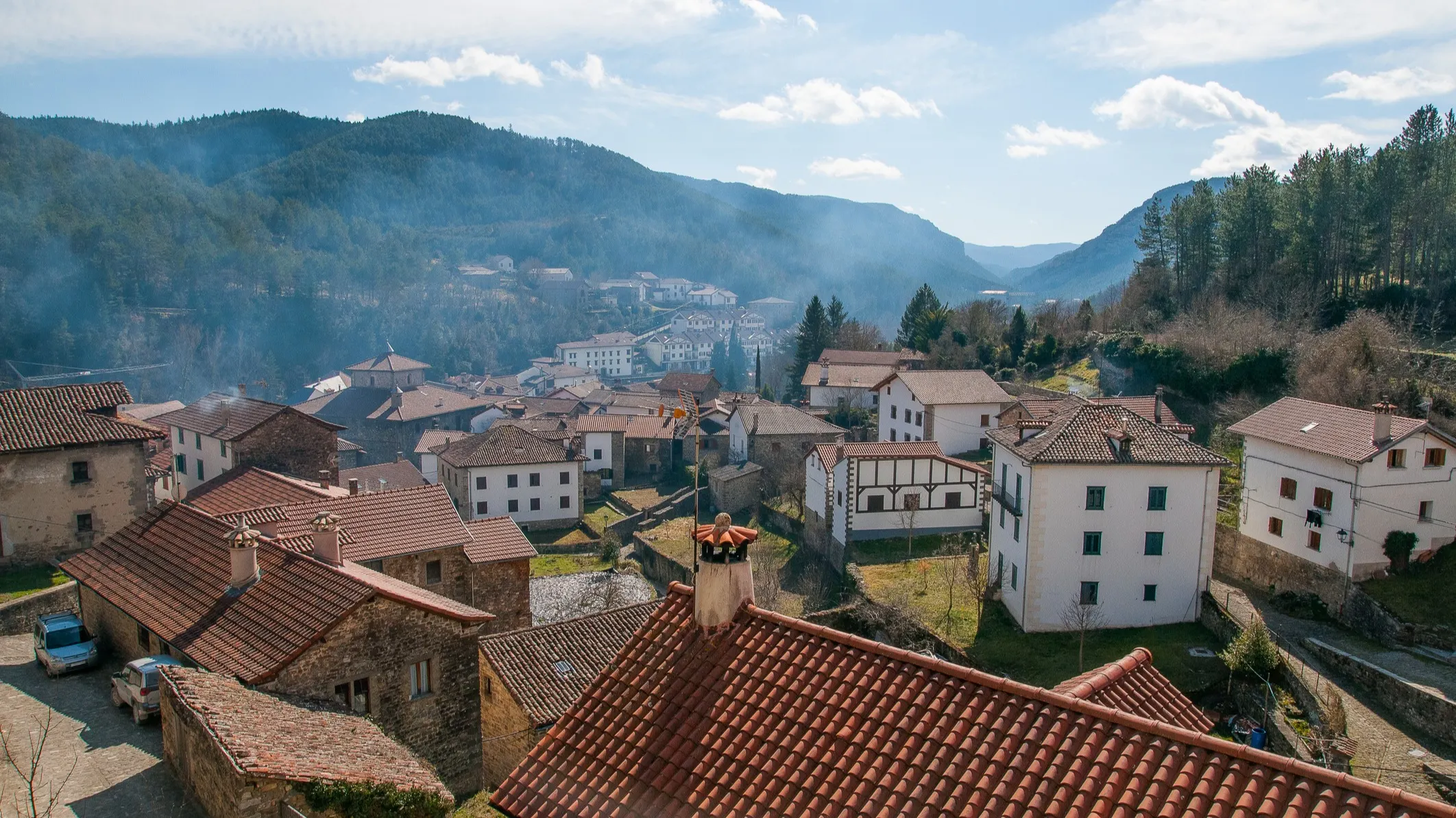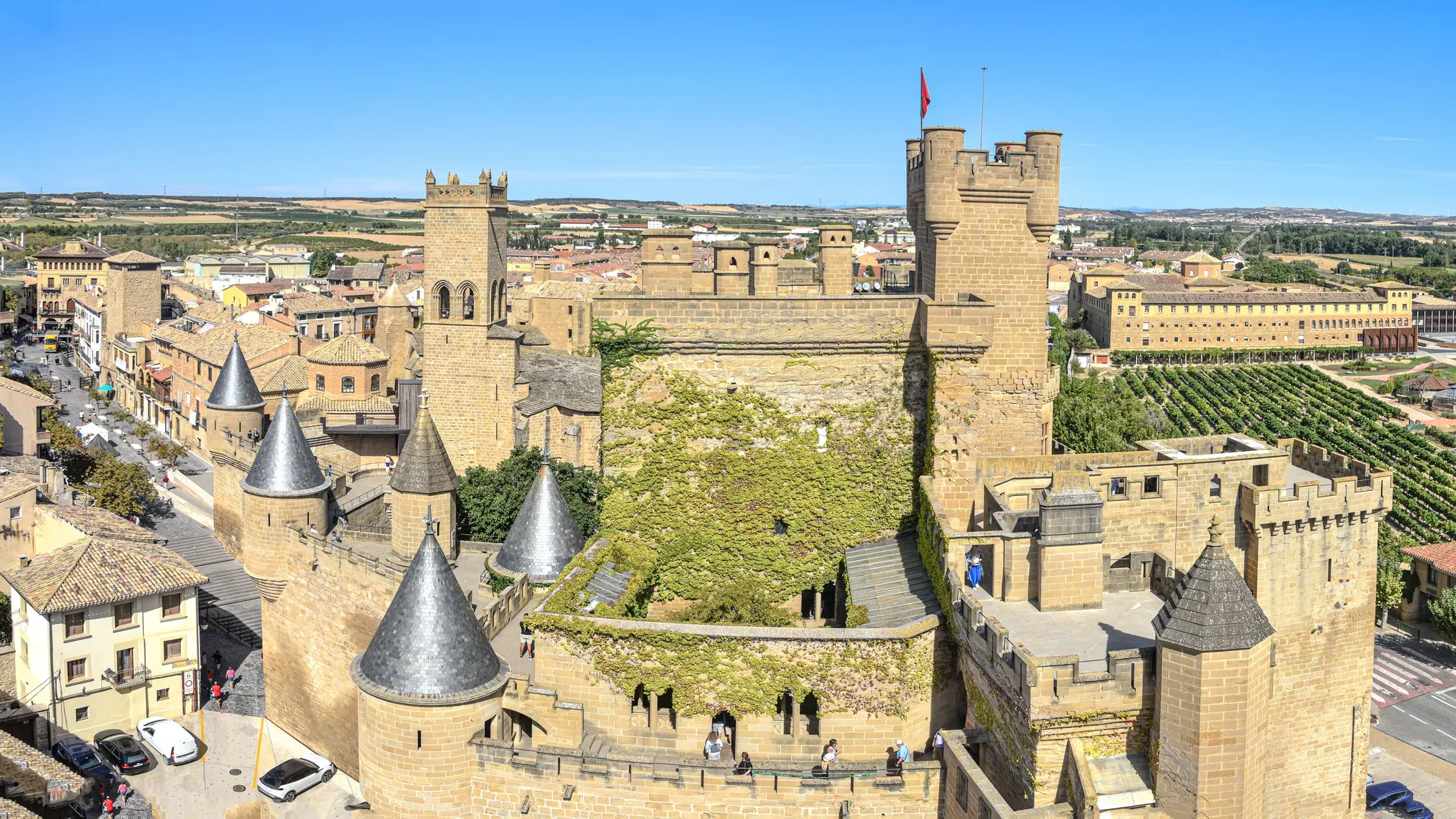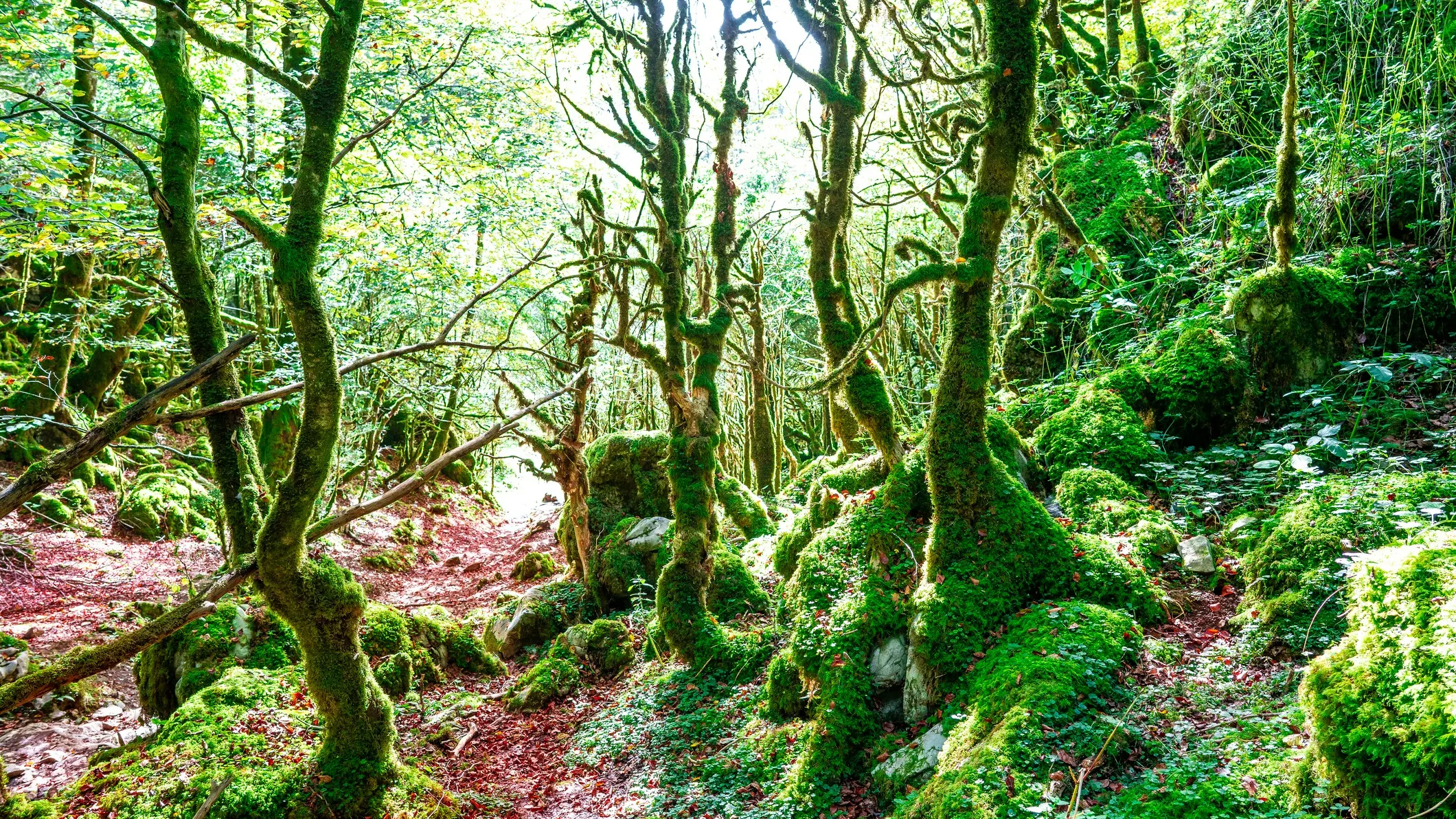In the mist-shrouded Basque Pyrenees village of Zugarramurdi, scores of 17th-century women were accused of practicing witchcraft during the Spanish Inquisition. Under torture, healers and midwives confessed to acts of devil worship in limestone caves, where a rushing stream named infernuko erreka ("stream from hell") bubbled up from the earth. Those who refused to confess were burned at the stake.
Four centuries later, my husband and I walked into the cool embrace of those same caves, grateful to escape the shimmering midafternoon heat. We followed the stream’s curving route through the shadows, accompanied by the soft whisper of water over rocks. The upper reaches of the caves soared overhead like the nave of a cathedral. Just enough light entered from either end to illuminate the immense space with the same ethereal glow as stained glass.
If traces of evil still lingered here, they were not evident on this quiet fall day. As far as I could tell, we were the only two people visiting the caves of Zugarramurdi. Birdsong from the surrounding beech forest drifted in our wake, but I barely heard it. My mind was fixed on the women documented in the nearby Witch Museum, whose knowledge of healing herbs and plants had made them targets of witch hunts.
Elena, a healer and midwife in my Miramonde historical fiction series set in these mountains, was inspired by those real-life women. I tipped my head back, imagining fictional Elena’s spirit swirling overhead, and felt a presence so powerful it moved me to tears.
We were only an hour’s drive from the bustling seaside city of San Sebastián, yet we’d entered an entirely different world. These caves—mostly untouched by time—were in the heart of the ancient kingdom of Navarra, where Basque culture has deep roots and locals still display an abiding respect for the supernatural.
Navarra is renowned for its Rioja wines and the annual running of the bulls in the capital city of Pamplona, but I was here to hunt for traces of the people, sites, and history that inspired my novels a decade ago on our first foray into the Pyrenees (see sidebar, The Tower of Oto).
With this second chance to explore the mysteries of Navarra, I hoped to uncover the region’s esoteric past and find inspiration for more historical tales. During the adventure that follows, we stay in a legendary thousand-year-old monastery and a restored medieval palace. We find powerful evidence of Navarra’s pagan traditions in a remote mountain village, and we come face-to-face with enormous predatory birds called griffon vultures.
Along the way, we sample world-class wines and regional cuisine, soak up magnificent mountain views, and savor the golden warmth of autumn.
A Legendary Monastery Reveals Its Secrets
The solemn clanging of a bell rang out across the courtyard from our room in the ancient Monasterio de Leyre, signaling the hour of Vespers. Answering the call, we followed a small group of people to the monastery’s Romanesque church. Cliffs looming in the north glowed pink in the last rays of the setting sun. The Pyrenean foothills were full of shadows.
We settled on a bench in the modestly proportioned church while the Benedictine monks who live here year-round filed in and took their places in the choir. Their voices mingled in song and echoed against the austere stone walls.
Though most of the men were getting along in years, a few younger monks stood among them, testament to the enduring attraction of Leyre’s monastic life.
The choir was honoring a thousand-year-old tradition; this complex has been home to a community of monks since medieval times. Leyre, first documented in the ninth century, is known as the "spiritual cradle" of ancient Navarra. The monastery’s pantheon contains the bones of Navarra’s first kings, and it is a historic refuge for pilgrims on the Camino de Santiago.
We weren’t here by chance. The great monasteries, convents, and castles of the Pyrenees region played starring roles in my historical mystery series, but many of them have fallen into ruin. Leyre, located on a rugged hillside a forty-minute drive southeast of Pamplona, presents a unique opportunity to experience a still-functioning monastery.
The two-star Hotel Hospedería de Leyre (we paid $100 per night) is located within the monastic complex; it provides comfortable lodging and friendly staff. But hotel visitors should be prepared for regular—and vigorous—bell tolling to signal the Liturgy of Hours that organizes monastic days from dawn to well after dark.

To visit the crypt beneath the monastery, my husband and I went to the visitor center, where we were given a key and instructions to lock up when we were finished. A shiver of anticipation ran over my skin as we approached a nondescript door in the high stone wall abutting Leyre’s cobbled entry drive.
A moment later, we crossed from the sunlit outside world into a chilly subterranean space. The hollow tread of our footsteps followed us through three staggered semicircular arches in diminishing sizes, like nesting dolls. We wandered through a stone forest of sturdy columns supporting the weight of the Romanesque church above our heads. For centuries, scholars have wondered about the possible inspiration for the delicate ribs, volutes, and scrolls that adorn the capitals crowning these columns.
Awestruck, I studied the enduring beauty of the artisans’ work and could swear I heard the scrape of their tools, the low murmur of their voices. Then the exterior door creaked open to admit another pair of visitors, interrupting my reverie.
A World-Class Birdwatching Experience—and a Brush With Magic
The next morning, we made the 20-minute drive north through Pyrenean foothills to the nature preserve of Foz de Lumbier.
The gorge is home to one of the world’s greatest populations of griffon vultures, and our visit fell during the peak autumn nesting period. These massive predatory birds with a wingspan of up to nine feet are a menacing presence in my books, a reminder that the Pyrenees wilderness is both beautiful and lethal. We walked the two-mile loop from here to the Irati River and entered the narrow passageway to the gorge. Here, limestone cliffs soared skyward, their layers alternating burnt umber and terracotta orange. Griffon vultures glided overhead, oblivious to us. Dozens of them sunbathed on limestone crags, surveying their domain.
Despite the presence of these predators, smaller raptors, herons, crows, and flocks of pigeons wheeled across the sky and foraged at the river’s edge. We’d landed in a birdwatcher’s paradise—albeit one with a Jurassic-era atmosphere. Dinosaurs grazing along the banks of the river would look right at home here.
Before returning to the monastery, we drove north into the Roncal Valley, an important setting for my novels and a place where respect for the supernatural persists to this day. The hour-long journey ran along the Esca River.
Steep hillsides flanked the route, the beech trees’ leaves just beginning to turn gold. Every slate-roofed home we passed was more beautiful than the last, pink and red geraniums spilling from the windowsills.
We set out on foot to explore the twisting cobblestone streets of the medieval village of Roncal-Erronkari, intrigued by the dried flowers adorning many doors we passed, their papery leaves rustling in the wind.
These sunflower-like silver thistle flowers, or eguzkilore, figure large in Basque mythology as an important defense against evil spirits attempting to invade homesteads. Legend has it that night-prowling witches and nymphs, spellbound by the flowers, counted the leaves incessantly until daybreak or fled to their underground lairs in terror of the coming dawn.
We stopped to examine a wall placard featuring a witch on a broom and the words Sorgine Etxea (Witch House). A tawny cat padded silently across the lane, tail twitching.
Whether this was the home of a practicing witch or not, the whimsical sign—and the silver thistle flowers guarding most houses—were evidence of the villagers’ enduring belief that supernatural forces exist in these mountains.
I smiled, a single word dancing in my thoughts: Magical.

A Dreamy Stay in a Medieval Tower
"We have a very special room for you in a palace tower," the hotel receptionist told us. "But you must be comfortable climbing twenty-one steps to get there."
We’d come to the small town of Olite to visit a multi-turreted palace inhabited by Navarra’s kings and queens during the medieval age. The three-star Olite Parador hotel now occupies part of that enormous stone complex. Yes, the narrow steps to our room in the former lookout tower were slightly challenging, but our extraordinary accommodation (we paid $149 per night) was worth the climb.
One floor of our tower lodging comprised a modern, white-tiled bathroom and an elegant bedroom furnished with antique bedframes (in Spain, a double room usually contains two twin beds pushed together), a generously proportioned table and chairs, and the largest wooden wardrobe I’ve ever seen. Our accommodation included a private lounge area up two more short flights of stairs, with comfortable couches, armchairs, and a coffee table.
The thick stone walls of our room evoked the tower’s original defensive purpose. The former arrow slits are now windows overlooking the nearby 13th-century Gothic church of Santa Maria.
This was the third Paradores de España hotel I’d stayed at in Spain. They’ve all been impressive. Over the past century, the state-run Paradores group has restored close to a hundred castles, monasteries, and other historic buildings throughout Spain, giving them new life as upscale hotels featuring fine dining. It was an unseasonably hot evening, and that night, most diners were drinking Olite’s famous rosés. (See wine sidebar below.)
The next morning at Pan & Degustación de Café, a local at the next table engaged us in conversation; she’d been to Chicago and wanted to talk about her favorite American experiences. We chatted in French, which is more prevalent than English here (though with a steady stream of British tourists visiting the town, most hotel staff and restaurant servers we met spoke some English). In this part of Navarra, many people speak Basque with native fluency, too. The teaching of Basque was once forbidden in schools, but it flourished even behind closed doors. Now it is an accepted part of school instruction; road signs display place and street names in both Basque and Spanish. We did our best to learn three important words during our stay, coached by encouraging locals: kaixo (hello), agur (goodbye), and eskerrik asko (thank you).
If you think these words look completely unfamiliar, you’re not alone. Some linguists theorize that Basque dates back to the Bronze Age and may be the oldest European language. Equally intriguing is the fact that no one has ever discovered a European language related to it… another mystery of the region.
After breakfast, we headed to the supermercado next door for picnic supplies. Before leaving Olite, we had some time-travel to do.
Olite’s Wine Pedigree Stretches Back to Roman Times
Olite has history to thank for its status as the epicenter of production for Navarra’s Ribera Alta wine region. Remnants of Roman settlements, roads, and walls abound in the area, and Romans loved their wine.
Later, religious orders providing shelter to pilgrims along the Camino de Santiago cultivated vineyards of their own (the busiest of the various pilgrimage routes, the Camino Francés, cuts through Navarra). When Carlos III established his lavish 14th-century court in Olite, wine production soared to keep up with royal appetites.
Today, bodegas (wineries) are plentiful in the area and vineyards still dominate the landscape. Olite is famed for its bright, mineral-driven rosés, which are typically made from the aromatic, fruit-forward—think cherries and raspberries—Garnacha variety of grapes.
For under $2 each, we sampled local varieties in two Olite bodegas a five-minute stroll from our hotel. Both had a welcoming atmosphere with staff who spoke some English.
Bodega Cosecheros is a cooperative founded in 1913 by dozens of local families determined to resurrect the wine industry after disease decimated vineyards in the late 19th and early 20th centuries. Their small onsite museum explains the history behind the cooperative and its many varietals of wine, and their lofty, well-appointed tasting room boasts a massive wooden "ovum," or egg-shaped wine barrel.
Of the wines we sampled, I most enjoyed their dry, refreshing rosé ($4.50 per bottle onsite). The cooperative’s wines are prevalent in Olite bars and restaurants for good reasons—high quality, low prices. To deepen the tasting experience, Bodega Cosecheros offers flights of three or four varietals paired with local products including goat and sheep’s cheeses, olive oil, and chocolate ($11-16 per person).
At Bodega Vega del Castillo (also a century-old cooperative), we sipped a white, a rosé, and a red—all excellent—and learned about the unique attributes of the Ribera Alta wine region. The area is hot and sunny much of the year, with cold winter temperatures and about 24 inches of rain annually. These conditions, along with the undulating landscape and proximity to the Pyrenees, make for an incredible diversity of soils and allow grapes to ripen very slowly. The result: ideal sugar, acidity, and aroma for wines of exceptional quality. ¡Salud!
Exploring Navarra’s Royal Palace

I stood in the Queen’s Hanging Garden, looking through an arched Gothic window at turrets and towers. Climbing ivy softened the lines of the covered walkway I sheltered in. Beautifully carved flowers decorated the capital of the slender column nearest me. A lone fruit tree stretched its branches toward the sun in the small, grassy courtyard.
I imagined Navarra’s Queen Leanor enjoying this view in the 14th century, after her husband Carlos III ordered additions to an existing castle built upon Roman fortress ruins. Upon its completion, the Palacio Real de Olite garnered a reputation as a seat of luxury in Europe.
It featured several of these "hanging gardens," courtyards set amidst fruit trees, and a menagerie of exotic animals, including giraffes and lions. Inside, the royal family enjoyed glazed-tile detailing, decorative plasterwork, exquisite tapestries, stained glass windows, and fine wooden furnishings. An onsite pelota court (pelota is a Basque sport similar to squash and racquetball) provided entertainment, along with jousting tournaments, bullfights, and lavish weddings.
The palace’s long slide into ruin began in 1512, when the Kingdom of Navarra was absorbed into the Crown of Castile and Aragón. Its decay was amplified when the Spanish military set the palace ablaze to prevent Napolean from using it for his own purposes. Restoration began in the early 20th century, and though it has never attained its former glory (it remains unfurnished), the palace offers an exhilarating trip back in time.
We happened to be there on a free admission day (entry is normally $5 per person), so we sailed through the gates and wandered at will through the maze-like complex. Emerging with delight from a twisty climb to the top of a tower, I saw my expression of glee mirrored on the faces of visitors who’d scaled another tower a stone’s throw away.
I took in the view of the palace, the church of Santa Maria, and Olite’s beautifully preserved medieval center. Olive groves, vineyards, and crop fields unfurled in every direction beyond the town limits. In the far distance, dun-colored hills glowed under bright sunlight. Upon our descent, we explored various restored spaces in the palace, including the Queen’s bed-chamber, the King’s gallery, and a lofty reception hall where banquets and balls were held. Most intriguing to me was a former guards’ room now known as the excavations chamber, where archaeological digs aim to reveal relics of medieval courtly life.
For a true immersion experience, Olite’s annual Medieval Festival during the second weekend of August offers a deep dive into the colorful past, with costumed locals engaging visitors in medieval music, dance, art, and more.
Taking the Magic Home

During our stay at the Monasterio de Leyre, my husband gifted me a necklace ornamented with a silver thistle flower. The ancient Basque symbol now travels with me everywhere. I like to think its protective powers extend to overly imaginative Americans as well as those with Basque ancestry.
What’s more, my long-held resistance to the supernatural has been supplanted by a deepening curiosity about the occult. There’s no denying it—Navarra, land of mystery and magic, has cast a spell on me so powerful that I’m now plotting out a new series of historical tales set in this hauntingly beautiful corner of the world.
The heroines of my stories? Witches, of course.
The Tower of Oto, A Life-Changing Vacation Rental

In 2012, I stayed in a place so unique, so beautiful, so soul-satisfying…. that it inspired me to write a novel.
Nestled close to the Pyrenees’ spectacular Ordesa y Monte Perdido National Park (a 3.5-hour drive from Barcelona or a three-hour drive from Toulouse), the 15th-century Tower of Oto was beautifully restored in the early 2000s. It has four floors connected by a wooden staircase, stone walls more than a meter thick, and magnificent mountain and valley views in every direction. The tower is part of a historic baronial home, and its owners are the descendants of that clan. My husband and I and our two daughters, then 10 and 13, walked from the tower into the hills and explored the abandoned village of Yosa, one of many such "ghost towns" in the Pyrenees.
We ate well in Oto’s adjoining town of Broto and picked up delicious baked goods a bit further down the road in the hillside town of Torla. On an afternoon hike, we marveled at Ordesa National Park’s limestone peaks, alpine meadows, and ancient beech forests. Nearly everywhere we went, the gentle clatter of bells drifted in the wind thanks to flocks of sheep ambling through the verdant landscape. We’d occasionally spy a shepherd and his dogs on the trails. At the time, I’d begun plotting out a historical mystery novel but hadn’t found the right setting for the story. My stay at the Tower of Oto changed everything. Now I had the perfect world and name for my fictional heroine, Renaissance-era artist Miramonde de Oto (Miramonde means "one who sees the world"). My creative muse was fully charged after our time in the Pyrenees, and the book was published a few years later. Its title: The Girl from Oto.
A British fellow reached out to me on social media not long ago, sharing a photo of his wife curled up with my book in an armchair at the Tower of Oto. (The owners of the tower, Elena and José, graciously keep the novel on display for visitors to discover.) I love the thought of my story living on within the centuries-old stone walls of that tower, offering an escape into another world for visitors lucky enough to spend a few nights there. I’m always hopeful that one day, I’ll stumble across another vacation rental that’s a perfect setting for a novel.
See the tower in all seasons from all angles on Instagram: @latorredeoto. The tower is available to rent ($273/night; 5 guests maximum) via Airbnb.
Editor's Note: This article first appeared in International Living magazine, a monthly publication that showcases the best destinations around the world to live, invest, travel, and retire well… for less. With correspondents based all over the planet, we bring you on-the-ground insights and expert recommendations you won’t find anywhere else--about real estate, health insurance, retirement planning, earning abroad, investing outside the dollar, taxes, visas and second passports, overseas home rentals, and more. Subscribe today with a special offer, here.
Get Your Free Spain Report Today!
Get Your Free Spain Report Today!
Learn more about the lower cost of living in Spain and other countries in our free daily postcard e-letter. Simply enter your email address below and we'll also send you a FREE REPORT — Live the Good Life in Sunny, Affordable Spain.

By submitting your email address, you will receive a free subscription to IL Postcards and special offers from International Living and our affiliates. You can unsubscribe at any time, and we encourage you to read more about our Privacy Policy.
